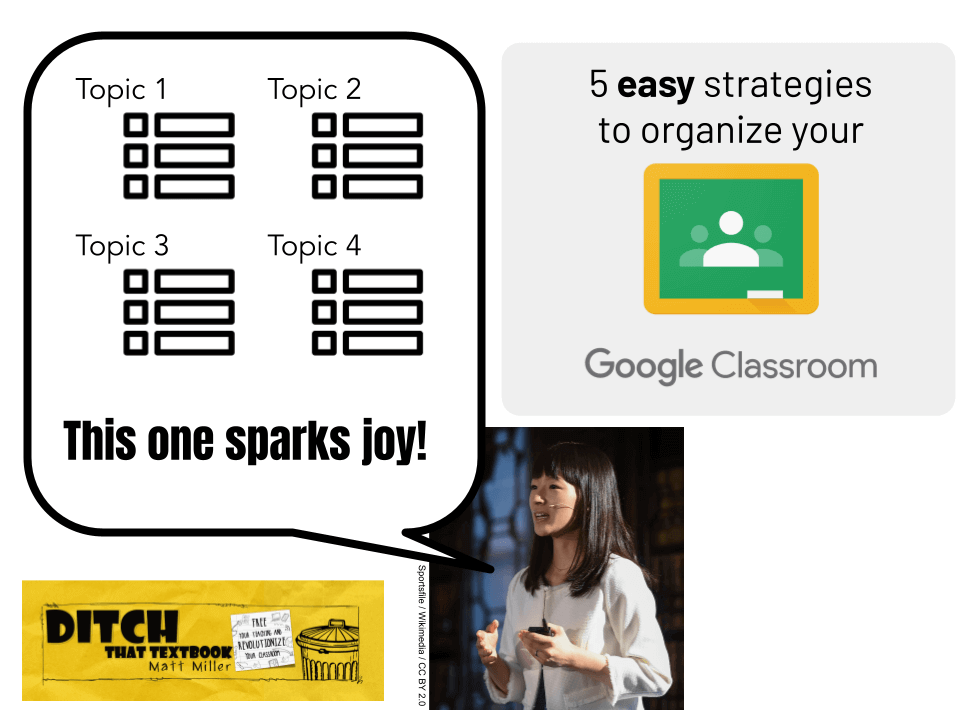
Is your Google Classroom a mess? An organizational disaster? Use these five strategies to get a handle on it!
Let’s be honest. Your Google Classroom is a hot mess.
If it is, you’re like many, many other teachers.
(If it’s not a hot mess, kudos to you. We can learn something from you!)
Thankfully, Google Classroom has a feature that helps you keep your classwork page neat and tidy and orderly — topics!
Some of the basics to know about topics:
- Topics are like headings for your assignments, questions and materials.
- Add a topic with the “Create” button on the classwork page.
- You can create almost as many topics as you want (max 100).
- Click and drag things on your classwork page under any topic.
Of course, how you use topics on your Google Classroom classwork page will dictate how effective and efficient they are for you.
Here are five strategies that can help make the most of Google Classroom:
1. Figure out where your prime real estate is.
Certain parts of your LMS are very visible to your students. These parts are often at the top of the page or in a place where students often look. I call these places “prime real estate.” They’re in an important, helpful spot. We should make the most of our prime real estate and make it work for us!
Some examples of prime real estate include a class banner image, the top of your classwork/assignments page, and the titles of your assignments.
That's just scratching the surface, and depending on your particular LMS, you may find that students' eyes are often on certain areas. Maximize them!
For example, here's how to maximize the banner image (first thing students see when they enter your classroom):
- Make your own custom banner image with Google Drawings
- File > Page Setup > Custom > 1600 X 400 pixels (ideal for Google Classroom, adjust to your preference) Note: the right third may be cut off on a mobile device.
- Download it as an image (File > Download as > PNG)
- Upload it to your LMS and update it as necessary
2. Number your assignments
Number your assignments so that they are easy for you and your students to find. Google Drive automatically creates a folder for your Google Classroom templates and the work created there so having assignments numbered will really help you when searching for or organizing assignments.
Check out this post by Alice Keeler on even more tips for organizing your Google Classroom by numbering assignments.
3. Pick the organizational structure that works best for you
If your classwork page were a filing cabinet filled with folders, what would you put on those tabs?
There’s a variety of structures you can use. And thankfully, you can change your mind. Topics are so easy to change. Topics are so easy to rename, add and delete. In a matter of minutes, you can switch to a brand new organizational structure if one isn’t working for you.
Here are some examples of structures you could use:
a. Sort by week
b. Sort by unit
c. Sort by subject or topic
d. Sort by file type
Of course, any of these can be modified. But having some suggestions can help you figure out which fits you best — or at least which one you want to try first.
4. Organize more deeply with subtopics
If you’re a super organizer (or an aspiring super organizer), you may think along these lines …
Organizing by unit sounds great. But each of my units has multiple chapters. And each chapter has multiple lessons. I wish I could organize my Google Classroom like an outline with points and subpoints — and sub-subpoints!
Guess what? You can! We just have to be creative with naming our topics and how we organize them.
For example, your organizational structure can easily go two levels deep — chapters and lessons. Figure out how you’ll type it in the topics so it fits nicely. Then, keep it consistent.
Here, just by typing them in the name, you have a chapter and a lesson.
Consistency keeps it neat! I abbreviated the word “chapter” but spelled out the word lesson. Why? For me, it fit in the space and I thought it looked good that way. However you decide to do it, stay consistent. It’ll make your topics much easier to scan for students. They’ll find what they need faster.
Let’s go crazy — three levels of organization!
In this case, I abbreviated everything: U1 for unit 1, Ch1 for chapter 1, L1 for lesson 1.
See … you don’t need an official function in Google Classroom for multiple levels of organization. Just make them yourself!
5. Use emojis and/or parenthetical abbreviations as tags
Let’s say your items in the Google Classroom classwork page have different characteristics …
- Some may have videos.
- Some may be written activities.
- Some may be from different academic subjects.
- Some may have different styles (poetry vs. short story vs. novel)
- Some may just be fun or funny things you want to share with students.
For any of those characteristics, assign an emoji in the name for that characteristic.
- On mobile devices, I’ll bet you already have an emoji keyboard! (If not, search for how you can add one to your keyboard.)
- On Chromebooks and devices with the Google Chrome web browser, use an extension like Emoji Keyboard.
- On Macs, use the Ctrl + Cmd + Spacebar keyboard shortcut to bring up emojis.
In our examples above, if your assignment includes a video, is a writing assignment and is a social studies activity, you could include one emoji for each of those.
To use this, basically think of what characteristics students might search your classwork for. Adding an emoji lets them find that assignment at a glance.
Don’t want to use emojis? (Or, want to add a second layer of tagging?) Try text-based tags instead! In the image above, I used (RES) for “research project”. Any activity related to the research project could be tagged with that (RES) abbreviation.
Are you ready to get your Google Classroom under control now???
- Find an organizational structure.
- Add subtopics (and sub-subtopics!).
- Use emojis or text abbreviations to assign tags to classwork.
Use one of those strategies. Use two or even all three! Then, watch as your Google Classroom falls in line with your organizational hopes and dreams!
FREE online course!
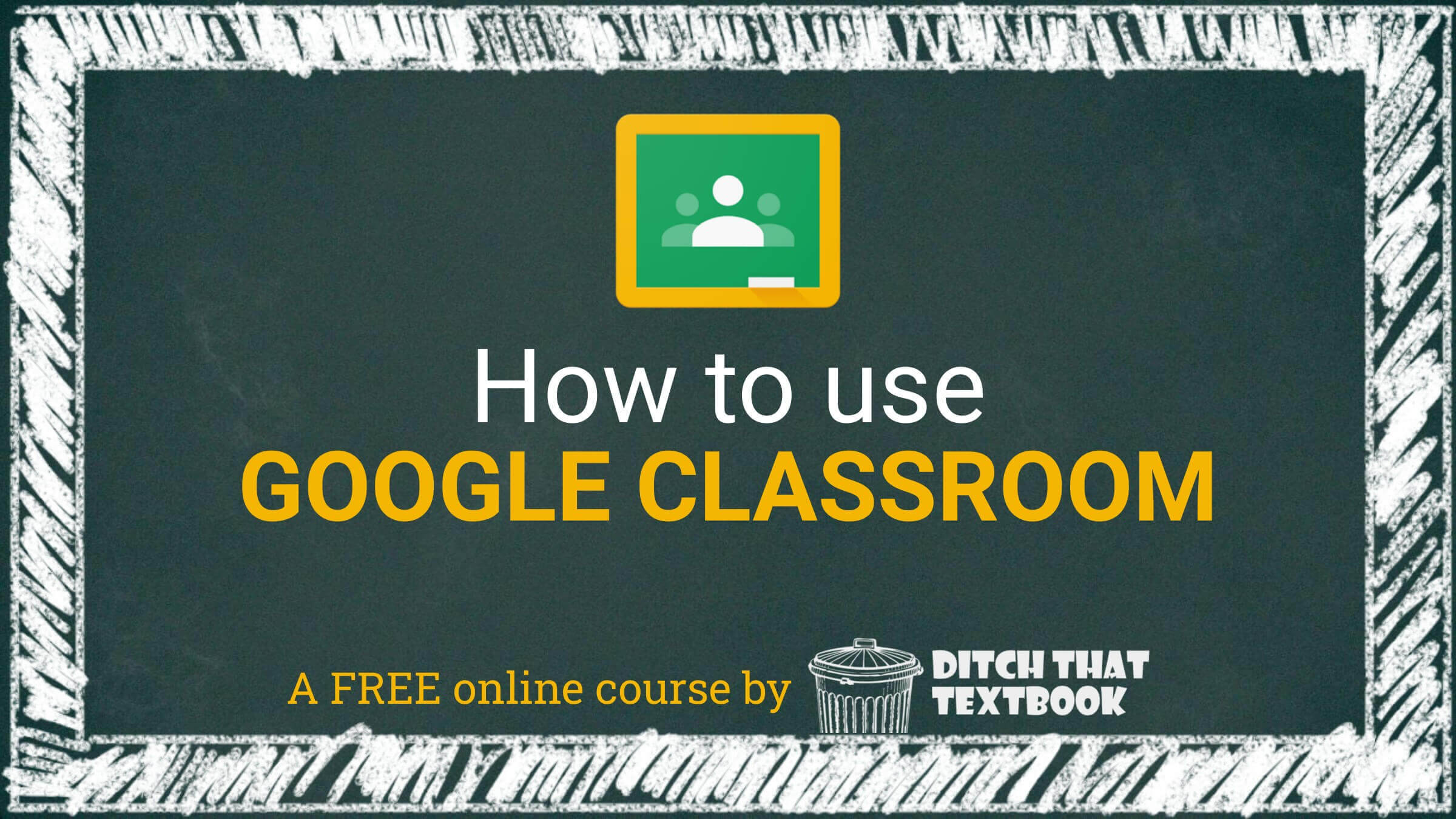
How to Use Google Classroom
⚙️ Tutorials to get you up and running
🛠 Organization tips and tools
💡 TONS of activities you can use right away
🚀 Ideas to take your skills to the next level
For notifications of new Ditch That Textbook content and helpful links:
Are you looking for quality, meaningful professional learning that both equips and inspires teachers?
Matt provides in-person and virtual keynotes, workshops and breakout sessions that equip, inspire and encourage teachers to create change in their classrooms. Teachers leave with loads of resources. They participate. They laugh. They see tech use and teaching in a new light. Click the link below to contact us and learn how you can bring Matt to your school or district!
Is Matt presenting near you soon? Check out his upcoming live events!

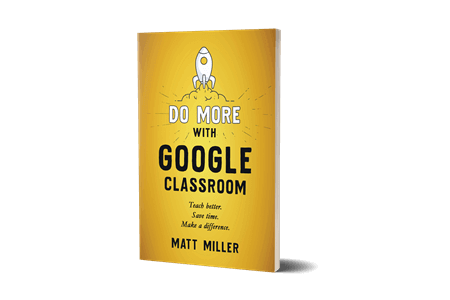

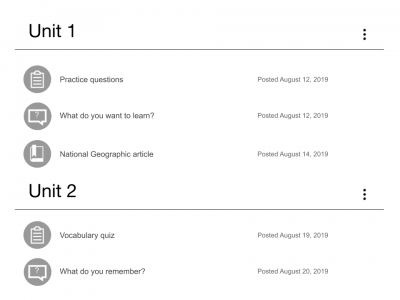

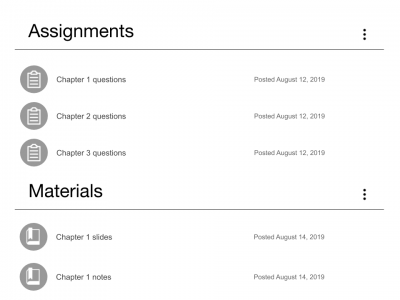





OMG Thank you! I am two weeks new to google classroom and have been so aggravated at the limitations of not being able to make subtopic under topics. I can’t function if my classroom isn’t fully organized and having one long list of things per chapter just was NOT working. This changed my whole way of doing things. Sanity restored!
I use each week for my topic, but use an emoji colored dot for each day of the week. Monday is a red dot, Tuesday is a blue dot, etc.
Matt you are incorrect in your statement that you can have as many topics as you want. You are limited to 100 topics. I just found this out. I’ve been using the date as topic and I’m getting close to my limit. 🙁
Ah! I stand corrected. You’re right, Chris. Thanks. Just found that in this “Limits when using Classroom” support page here: https://support.google.com/edu/classroom/answer/7300976?hl=en
I have work divided by Unit-Week-Day as a Topic. Now i
I need to separate by 1.9 grading period and 2.9 grading period. Finally by Fall Semester to get ready for Spring. Can this be done?
I think if you used a consistent naming structure (the subtopic thing I mention above) you could get it done. You might also consider breaking your semesters up into two Google Classroom classes — a fall class and a spring class — so you can have a clean reset for the new semester.
Was already separating by subject. Will try other ways to separate … Thanks!
You bet Sonia!
It is the end of a quarter. Is there an easy way to move all Quarter 1 topics into one topic (all Quarter 1 Assignments) to clear things up for Quarter 2?
Couple ways you could do this …
1. You could move all of your quarter 1 stuff into a QUARTER 1 topic at the bottom of the classwork page.
2. You could start a new Google Classroom class for each quarter.
If you wanted to move all of them into one Quarter 1 topic, it’d be a lot of dragging and dropping. No faster way I know of (unless someone else suggests something here!).
If Emoji Keyboard (and other apps) are blocked you can use this workaround.
To get the emojis I opened a Google Doc, clicked Insert –> Special Characters, then changed Symbol to Emoji and just looked through the options. Click on an emoji to insert it into your Google Doc then copy from the doc and paste into the Classroom Assignment. This works because Google treats these like text instead of images.
Yesssss! THIS! 👆🏻👆🏻👆🏻 Thank you Lisa!
thanks, but now are you gonna show us how to organize?
Umm … organize with one of the structures, organize with subtopics, organize with emojis? That’s a bunch of organization, right?
This was very useful information. I know i will be using it this fall! Thank you so much.
Thanks! 🙂
I think adding tags and bit emojis are awesome ideas for working with kids.
Me too! Plus they get to the visual part of their brain. Win win.
Interesting – in a direction I would like to go.
Glad to hear that.
This was very useful information. I know i will be using it this fall! Thank you so much.
Happy to hear that Sarah!
Thank you for the information. This will help me greatly in the future.
Glad to hear that!
[…] Check out other recommendations from Alice Keeler, Shake Up Learning, and Ditch That Textbook. […]
Mr. Miller, thank you for the helpful information. I will definitely use it.
Excellent! Thanks Carol!
Mr. Miller, thank you for helping so many like me that needed so much help!
My pleasure! Thrilled to get to support you!
Thank you for the quick and beneficial information!
My pleasure, Bethany!
This was great information. I will be using these strategies this year. Thanks.
So glad to hear that!
[…] […]
[…] Want more inspiration? Check out other recommendations from Alice Keeler, Shake Up Learning, and Ditch That Textbook. […]
That was very helpful. I saved for later reference. Thank you.
Excellent! Thanks Shannon!
Thank you for the help and information!
Thanks for reading John!